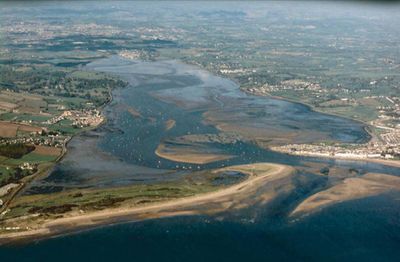Difference between revisions of "Portal:THESEUS/Plymouth sound to Exe estuary"
(table) |
|||
| Line 41: | Line 41: | ||
{| | {| | ||
| − | |||
! | ! | ||
! Background issues | ! Background issues | ||
| Line 52: | Line 51: | ||
| innovative approach to beach reprofiling or managed retreat | | innovative approach to beach reprofiling or managed retreat | ||
|- | |- | ||
| − | | | + | | Teignmouth |
| − | | | + | | flooding of town, new flood defence scheme in the planning stage with Environment Agency support |
| − | | | + | | maintain the line or abandon and relocate population and infrastructure or accept more frequent flooding (flood proofing + flood warning) |
| − | | | + | | innovative demountable barriers, warning systems and traditional engineering defences |
|- | |- | ||
| Element | | Element | ||
Revision as of 13:51, 10 March 2010
The geographic area covered by the Plymouth sound to Exe Estuary (South Devon) encompasses a 100 km stretch of coastline of SW England bordered by the English Channel. The site is one of the most diverse coastal settings in Europe and incorporates a range of habitats from exposed rocky and shingle coast to sheltered mud of flooded valleys or 'rias' together with densely populated urbanised and industrial zones of Plymouth Sound and Torbay. Therefore, it is a unique and representative site to involve the complex coastal and estuarine processes; interaction between coastal defence structures and coastal morphology; and significant economic, social and environmental impacts. Plymouth to Exeter area covers the city of Plymouth, the towns of Teignmouth and Newton Abbot, and the Exe Estuary (city of Exeter, towns of Exmouth, Dawlish, Star Cross, Lympstone). Plymouth is a large naval port, Teignmouth is a modest merchant port, the Exe Estuary is a site of special scientific interest and also provides vital flood defence for the mainline railway and the city of Exeter, which is the regional centre of light industry. The combined population of these conurbations is ~ 500’000. This area is covered by the Plymouth Coastal Observatory which has an ongoing intensive programme of data collection comprising: waves, tides, beach surveys, storm response, ecological mapping, LIDAR surveys, etc, but focussing on the coast and estuaries. ARGUS video imaging allowa the monitoring of two sites along this coastal tract, at Slapton and at Teignmouth. Historical data includes tide gauge data at Teignmouth, Exmouth, Plymouth, as well as scientific output from the COAST3D project, and coastal management reports commissioned by the local authorities such as SDADCAG. The problems associated with storm events, flooding and coastal zone management of this pilot site are many and varied and differ fundamentally along its length. There are areas of pristine habitat, which may be used to provide reference conditions, together with densely populated and industrial areas. There are a multitude of different users of the coastline and numerous impacts. Issues relating to storms and flooding include: coastal erosion modification of coastlines via coastal defences such as LCS and groynes, saltwater incursion and managed retreat. In addition there has been considerable 'hardening' of the substratum through building and development centred in two main areas, Plymouth Sound and Torbay. Both these areas are sheltered, relatively enclosed embayments with important marine habitats and a large urban influence. Plymouth Sound is protected by a substantial (1.3km in length) breakwater which was constructed in the 1850’s. This structure is maintained annually by addition of substantial quantities of concrete scour defence. Experimental work on biological enhancement of coastal structures will be focused here. Together with the engineering contractors we have sought permission to modify concrete scour defence as part of the THESEUS experimental trials. The site is excellent for such work as it is convenient for access by boat from the University Marine Centre (~1km), but access by others is strictly regulated by the Ministry of Defence. A major modifier of the coastline is the railway line (Fig. 6)which has been in place since the 1950's and occupies considerable stretches of coastal frontage (Exeter to Dawlish to Teignmouth to Newton Abbot). Coastal defence work to protect the railway line has modified coastal processes. Pressures include physical disturbance, for example by trampling, dredging, fishing gear, land claim and adjacent coastal development through the construction of sea defences and potential for changes in the hydrological regime.
| Background issues | Scenarios | Possible solution/s | |
|---|---|---|---|
| Slapton | flooding and erosion | maintain the defence line or 'do nothing' | innovative approach to beach reprofiling or managed retreat |
| Teignmouth | flooding of town, new flood defence scheme in the planning stage with Environment Agency support | maintain the line or abandon and relocate population and infrastructure or accept more frequent flooding (flood proofing + flood warning) | innovative demountable barriers, warning systems and traditional engineering defences |
| Element | Element | Element | Element |
| Element | Element | Element | Element |
| Element | Element | Element | Element |
